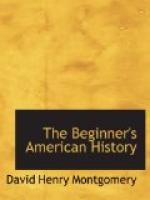[Footnote 7: Lisbon: see map in paragraph 21.]
4. What men then knew about the world.—The maps which Columbus made and sold were very different from those we now have. At that time not half of the world had been discovered.[8] Europe, Asia, and a small part of Africa were the chief countries known. The maps of Columbus may have shown the earth shaped like a ball, but he supposed it to be much smaller than it really is. No one then had sailed round the globe. No one then knew what lands lay west of the broad Atlantic; for this reason we should look in vain, on one of the maps drawn by Columbus, for the great continents of North and South America or for Australia or the Pacific Ocean.
[Illustration: The light parts of this map show how much of the world was then well-known; the white crosses show those countries of Eastern Asia of which something was known.]
[Footnote 8: See map in this paragraph.]
5. The plan of Columbus for reaching the Indies by sailing west.—While living in Lisbon, Columbus made up his mind to try to do what no other man, at that time, dared attempt,—that was to cross the Atlantic Ocean. He thought that by doing so he could get directly to Asia and the Indies, which, he believed, were opposite Portugal and Spain. If successful, he could open up a very profitable trade with the rich countries of the East, from which spices, drugs, and silk were brought to Europe. The people of Europe could not reach those countries directly by ships, because they had not then found their way round the southern point of Africa.
[Illustration: This map shows how Columbus (not knowing that America lay in the way) hoped to reach Asia and the East Indies by sailing west.]
6. Columbus tries to get help in carrying out his plans.—Columbus was too poor to fit out even a single ship to undertake such a voyage as he had planned. He asked the king of Portugal to furnish some money or vessels toward it, but he received no encouragement. At length he determined to go to Spain and see if he could get help there.
On the southern coast of Spain there is a small port named Palos.[9] Within sight of the village of Palos, and also within plain sight of the ocean, there was a convent,[10]—which is still standing,—called the Convent of Saint Mary.
One morning a tall, fine-looking man, leading a little boy by the hand, knocked at the door of this convent and begged for a piece of bread and a cup of water for the child. The man was Columbus,—whose wife was now dead,—and the boy was his son.
It chanced that the guardian of the convent noticed Columbus standing at the door. He liked his appearance, and coming up, began to talk with him. Columbus frankly told him what he was trying to do. The guardian of the convent listened with great interest; then he gave him a letter to a friend who he thought would help him to lay his plans before Ferdinand and Isabella,[11] the king and queen of Spain.




